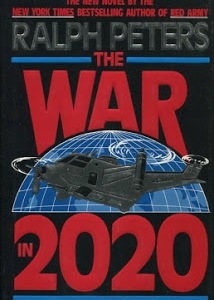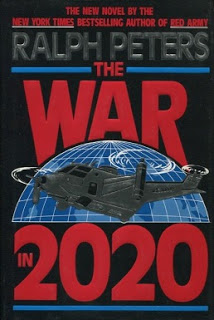Reading this book made me realize, as bad as 2020 was, it could really have been a lot worse. Originally written in 1990, Ralph Peters’ The War in 2020 is now firmly in the territory of alternate history. Penned in the twilight of the Cold War, the Soviet Union had not yet undergone its dramatic collapse, in many supposedly well educated circles there were fears that a technologically ascendant Japan would make the United States obsolete with a few strokes on a keyboard, and the old securities of an ascendant America might slide out the window. We weren’t quite at the farcical End of History period some predicted, and there wasn’t yet only one superpower. It was, in some ways, very easy to imagine a different 2000, one where there were more rising powers and impotent old enemies.
The mildly prescient tagline includes “The World of the 21st Century is barely recognizable. War has ravaged almost every continent – a pandemic plague has swept impartially around the globe“, which, in light of a Drug War in Mexico, numerous warm or hot wars in Central Asia, Africa, the Middle East and Europe, seems eerily prescient. The world Peters imagines and our own 2020 also happens to coincidentally be one where a global pandemic is ravaging the world. A black man with a southern VP sits in the White House, and the United States is engaged in multiple open ended military campaigns far from home. Thankfully though, this isn’t that, and merely rhymes discordantly in the bizarre present we find ourselves in
Peters’ imagines a United States having watched its old Soviet enemy fade into obscurity, and so has decided it can downgrade on defense spending. This comes to bite them in the ass as Japan uses its technological know how and powerful trade and economic muscle to propel itself to being a power not to be trifled with. They decide to institute a long running series of proxy wars designed to gradually sap American strength and in the wake of a brutal global pandemic, move to collapse one fading power and potentially eclipse all others in Eurasia.
Enter George Taylor, a survivor of a disastrous American intervention in Zaire, where a brief fight against a Japanese backed South Africa ends in debacle, and spreads the new plague to America’s shores. He fights in a few smaller proxy wars before finding himself at the tip of the spear in Soviet controlled Central Asia. Supporting him are Howard “Merry” Meredith, Manuel Martinez, and David Heifetz, honest men who are trying to make the best of a bad situation. They’ve formed bonds through blood and steel, through campaigns from urban pacification in the continental US, to anti-guerilla campaigns in Latin America. Facing an unprepared and disease gutted military at home, and an only semi-functional at best of times and shambolic at worst allied Soviet military, the men must do what they can to stem the tide of separatist rebels propped up by Japanese advisors and technology.
The story then follows this diverse cast of characters across Washington, Moscow and the Central Asian steppes. There’s predictions about the future of warfare, technological progress and how it affects war fighting. We have some hit and miss interactions. I don’t necessarily read older works for their predictions on the future, but I do tend to love how hit and miss things can be. Needless to say, much of the technology predictions and geostrategic ones are completely unrelated to our world. The various wonder weapons and technology dreamed up by the author bear no real resemblance to what a battlefield in our own world looks like. As cool as vehicle mounted laser weaponry, massive computer guided warfare, and ever versatile fighting vehicles is, we’re not really close to it.
That said, the M-100 fighting vehicle portrayed in the novel deserves some mention. It’s an air cavalry vehicle which functions as gunship, command ship, electronic warfare vehicle and troop transport all in one. In can move a unit of dragoons into a combat zone, take out hundreds of armored and support vehicles by itself, and jam enemy signals at the same time. It can hide itself with camouflage with few restrictions, and is a top of the line fighting vehicle replacing the old Apache gunship. Essentially, it’s an amazing wonder weapon which can do many things, a jack of all trades, but master of none. Peters actually portrays it as being less than infallible, mechanically problematic, and all its systems are so new it doesn’t necessarily work one hundred percent as advertised. This honestly made it a rather refreshing system to be shown in a techno-thriller.
What I truly appreciated about the story is that Peters didn’t portray it as one side effortlessly crushing the other. The Soviets are driven back by Japanese technological superiority and the strength of local forces, but in a few cases manage to make savage and punishing counter attacks. The Japanese technical superiority is undone by emerging American weapons systems and those in turn are stretched to their limit by being untested in the field while not being totally superior to their Japanese counterparts. There’s no wonder weapons, no side is presented as woefully inferior to the other, and even the ostensibly inferior powers manage to take the superior by surprise.
Peters writes war exceptionally well. I rarely found myself enthused in the vein of a Tom Clancy novel or a David Weber fare, or bored by the predictable curbstomping of one side. It was nuanced, and the barbarity, the cruelty, heroism and suicidal commitment to duty were showcased in equal measure on all sides. Both sides largely believed in their own cause, wanted to win for their own reasons, and did the best they could with the material they had. They were even hampered by poor political decision making by their respective leaders and subordinates, whether those be in Tokyo, Moscow or Washington. It left commanders frustrated, shackled, or sick with worry about their choices. There were massacres, the use of weapons of mass destruction, and very grim realities of modern war. It was a bloody business, and very nicely done.
I truly enjoyed that Peters made his characters flawed. Colonel Taylor for instance, hates the Japanese with a vicious streak that borders on pathological. This isn’t portrayed as a virtue however, and even Taylor admits that it impairs his judgement. His subordinates have a fanatical desire to please their commander, and they all have their own flaws. This, in a few cases, leads directly to their deaths. Their enemies are not simple cardboard cutouts, some don’t actively believe in their cause, and others simply fight to fight on another day. I appreciated that there wasn’t any dues ex machina which forced the scales one way or another, and indeed I was actively in suspense about the outcome until the end.
This isn’t to say the book is without flaws. The portrayal of the female characters was pretty atrocious. I found myself mildly reviled by the way a few of the woman were portrayed and even some of the men talking about women (if accurate in a gross misogynistic sense) was unreadable. I tended to skim over those parts. The portrayal of the Muslim characters does lack similar nuance, and by and large they do serve as the disposable cannon fodder of the story, being the acceptable antagonists. They lack a certain nuance that writers unfriendly to them today would find striking, but in the name of a popcorn action read, you could gloss over it without thinking too much.
My final assessment of this book though, is that Ralph Peters does military fiction right. He doesn’t provide some miraculous solution to the conflict, there’s no instant win the characters can pull off, and there’s high and real stakes. People die and you can actually feel those losses. The characters are well established enough that I can sympathize with their loss, and there is glory, but also horror, in war. The ending doesn’t provide you with all the solutions, and you might even wonder what these characters will move on to, but such is life after war. The War In 2020 may not have quite predicted the future, but it does tell an entertaining story of a future that never was.



3 thoughts on “The War in 2020”